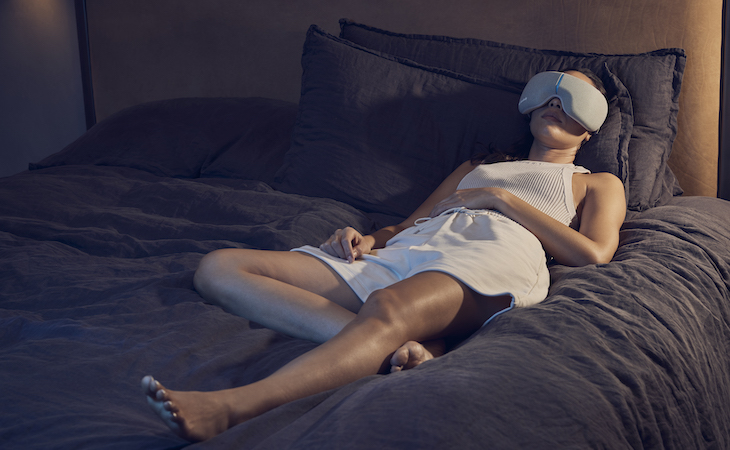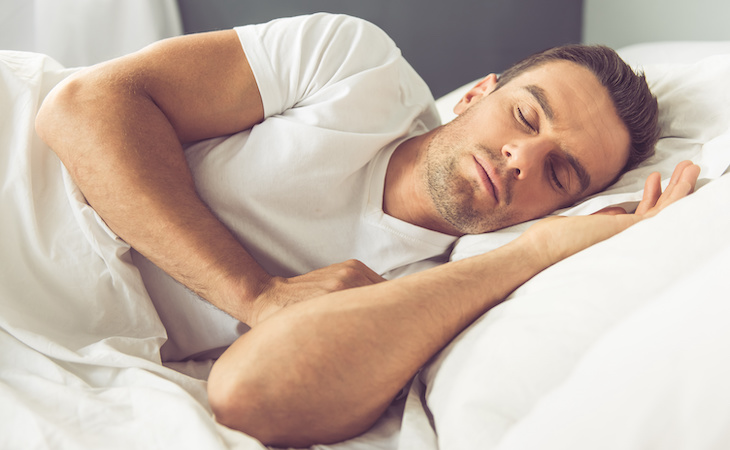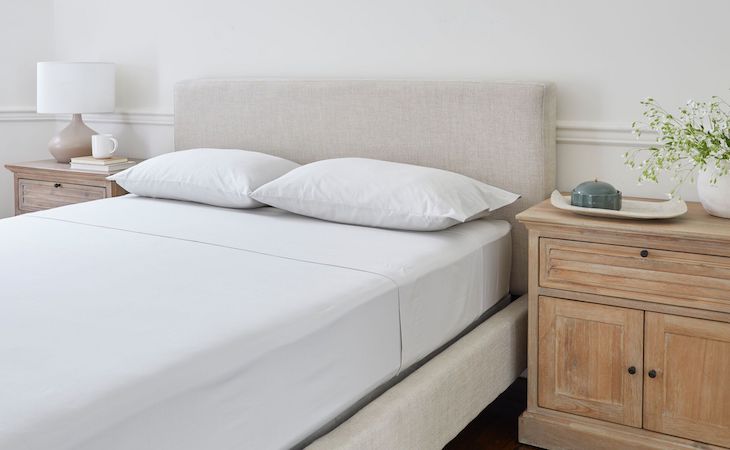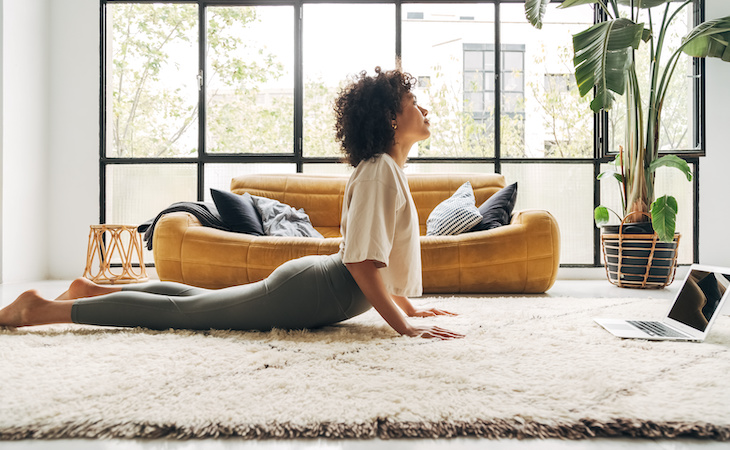From sleep trackers to meditation apps, it seems like there’s a new piece of tech every single day that promises to help us sleep better. But with so many items out there (and most of them not cheap), it’s hard to figure out which ones actually work the way they should.
However, after a slew of work travel that left me way too jet lagged for my own good, I was prompted to try a new product from my favorite massage device company: The Therabody SmartGoggles, which use the brand’s signature massage therapy and vibration patterns, combined with heat therapy, to help reduce one’s heart rate and bring down stress levels—thus resulting in increased focus and (allegedly!) better sleep.
While I’m usually a great sleeper—thanks to a regimented schedule and a stint with a sleep therapist to help figure out my patterns—at that point, it really felt like the stress of work travel (including an international trip to Japan) and constantly staring at screens to catch up on an influx of work had left me perpetually tired and cranky but unable to turn my brain off enough to sleep.
The jet lag was tough, and even if I forced myself up all day, I just wasn’t able to fall asleep at night. So, I figured I had nothing to lose and decided to try the device for a month to see whether it worked. Here’s my honest review.
What’s a smart eye mask?
A smart eye mask is essentially the same shape as a regular sleep mask, but it adds enhanced features through tech. While the features vary overall, a smart eye mask could have anything from integrated audio or meditation to help sleep, light technology, massage or vibrational therapy, sensors for tracking heart rate and sleep, and even weighted eye pads to mimic a weighted blanket. They’re designed to help improve sleep through a number of different mechanisms, depending on the features they offer.
Smart eye masks vs. regular sleep masks
The main difference between smart eye masks and regular sleep masks is their features. A regular sleep mask usually consists of soft, hypoallergenic fabric (more often than not, that’s silk) and adjustable straps to block out all light and help people sleep better: In fact, a 2023 study found that wearing one nightly improved sleep and boosted cognitive function and alertness the next day.
A subset of the regular sleep mask category is also the weighted sleep mask, which uses a weighted material, such as microbeads or sand, to put a little pressure on the eyes and help you decompress. While weighted blankets have been proven to promote sleep and reduce insomnia, there hasn’t been conclusive evidence about weighted sleep masks just yet. However, they seem to use similar mechanisms, and people do believe that they work.
As of now, there’s also only anecdotal evidence pointing to the increased effectiveness of smart eye masks that contain all those additional features mentioned above. But it’s been suggested that by adding these options proven to help sleep (meditations, massage, etc.), they can have additional benefits to helping sleep than simply using a regular eye mask alone.
Benefits of smart sleep masks
Smart sleep masks have been said to have the following benefits:
- Help soothe headaches
- Alleviate eye strain
- Bring down blood pressure
- Reduce stress
- Promote better sleep
- Lower heart rate
- Aid in relaxation
- Increase blood circulation
- Ease facial tension
As mentioned earlier, these benefits are primarily anecdotal and haven’t been backed up by any studies as yet since the research on smart sleep masks is still new.
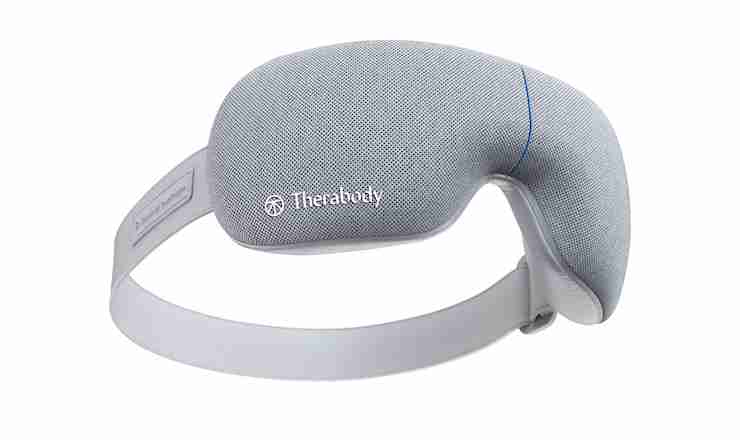
Smart sleeping mask review
Personally, I was incredibly intrigued by the smart sleeping mask. Having tried multiple meditations and weighted eye pillows in the past, I was curious to see what difference the Therabody SmartGoggles could make—especially given the fact that I was dealing with a particularly nasty bout of jet lag that was nearly impossible to get rid of.
Having had a whirlwind six-day trip to Japan, the 14-hour time difference meant that I could neither wake up in the morning nor fall asleep at night, no matter how many melatonins I popped or how many “relaxing” meditations I attempted. So, I spoke to Tim Roberts, VP of science and innovation at Therabody, to weigh in on why my sleep might be so affected and how the SmartGoggles could help me sleep better.
“Poor sleep can happen for many reasons, but two of the larger reasons are the use of screens in the time before bed, as well as physical/mental stimuli that can cause our minds to race and lead to stress,” says Roberts. “The design of the SmartGoggles (covering the eyes across the brow and face) means that you’re able to take a moment to pause, be still in your nightly routine, and—through the treatment—quiet your mind and relax. The combination of shutting out external stimuli, vibration therapy and massage, plus taking dedicated time to transition, help build great habits that are proven to improve the quality of your sleep.”
Personally, I was incredibly intrigued by the smart sleeping mask. Having tried multiple meditations and weighted eye pillows in the past, I was curious to see what difference the Therabody SmartGoggles could make—especially given the fact that I was dealing with a particularly nasty bout of jet lag that was nearly impossible to get rid of.
While I’m usually pretty diligent about getting rid of screens before bed, I was unable to shut my brain off for several nights after my trip to Japan even sans screens, resulting in a very groggy morning more often than not. Roberts said I should use the SmartGoggles for a minimum of five minutes every night for a week to see if they helped, but I could go up to as long as I liked in terms of how many minutes I used them for.
The programs on the SmartGoggles range from five to 30 minutes and consist of three specific modes: Sleep, Focus, and SmartRelax, all of which utilize different elements to help the body.
I used Sleep the most, which uses massage and vibration (not heat, as the company says the body needs to cool down in order to induce sleep), and kept it on for 10 minutes right before bed for a week. The massage and vibration caused the most pressure around the temples, which helped calm me down, while the sturdy elastic band kept everything in place without being too tight.
The weighted cushion was comfy and covered all light. I also had the option to pair my sessions with a soothing meditation, which I chose to do quite often in order to add to the effects.
I will say that it was incredibly convenient to be able to control everything from my phone because the buttons on the device itself were pretty bulky. The SmartGoggles were also foldable and easy to store away while not in use, but the battery life could’ve been better—I only got about four uses of 15 to 30 minutes per full charge.
While it took me the first couple of days to simply get used to the device on my temples, there’s no denying that I felt incredibly calm using the device, and it helped reduce my heart rate too.
While I wouldn’t say that the SmartGoggles immediately made me drowsy, they did help get me in the mood to sleep much more effectively than a long, drawn-out bedtime routine did. The complete darkness and lack of blue light was a welcome reprieve from my day of phones, and I found that instead of taking sometimes an hour to fall asleep, I was able to zone off and get myself to sleep in less than 30 minutes.
I also tried the device with me on a trip to India later in the year and found that I adjusted to the time zone pretty quickly—only about two days to get acclimated as opposed to the usual four or five that it used to take.
Overall, I did feel like the device helped to relax me and get me in the mood to sleep quickly—it’s not to say my normal routine wouldn’t do the trick, but the SmartGoggles made me feel relaxed much quicker, which was great when I knew I needed to be up early and had to maximize all the sleep I could get!
The only major issue I had with the device was really the fact that it was bulky to operate directly without an app, and of course, the battery life.
FAQs
Is sleeping with a smart eye mask healthy?
It’s always best to check with your doctor before using any sleep tech, says Roberts, especially if you have health issues that could be affected by vibration or light—think seizures, low blood pressure, or recent eye surgery. There’s also a list of precautions on the Therabody website that suggests which people not use the mask, such as those with hypertension or tumors.
Images courtesy of Therabody





